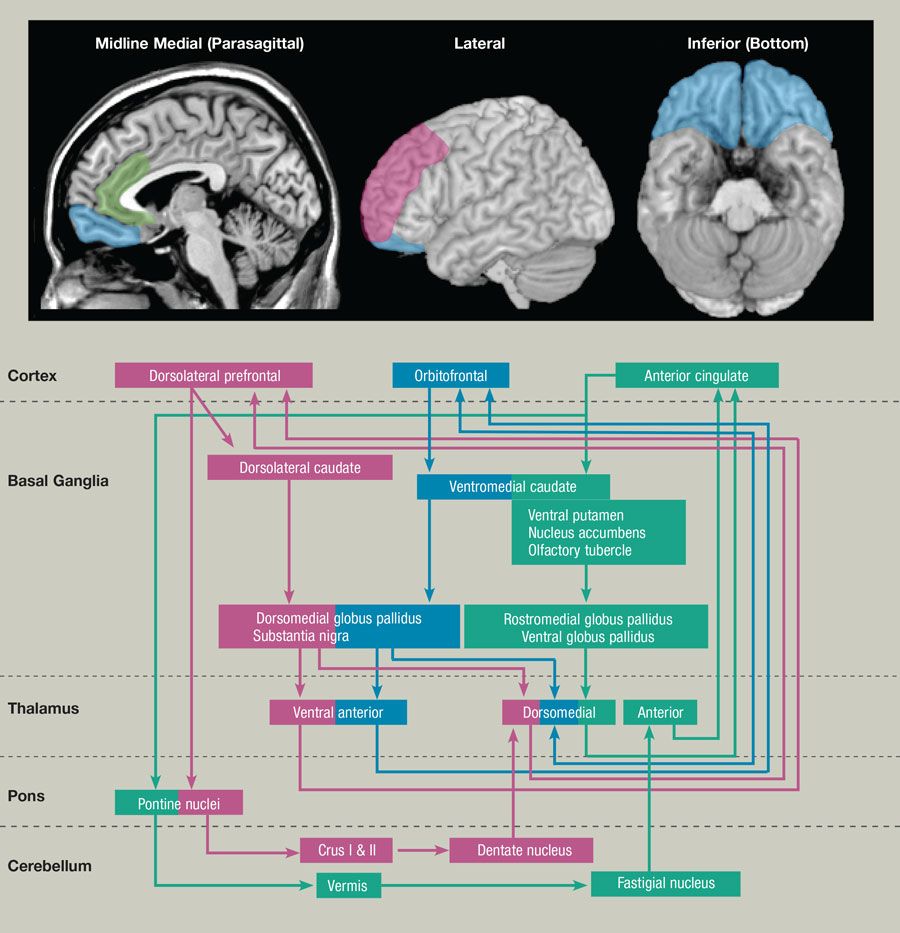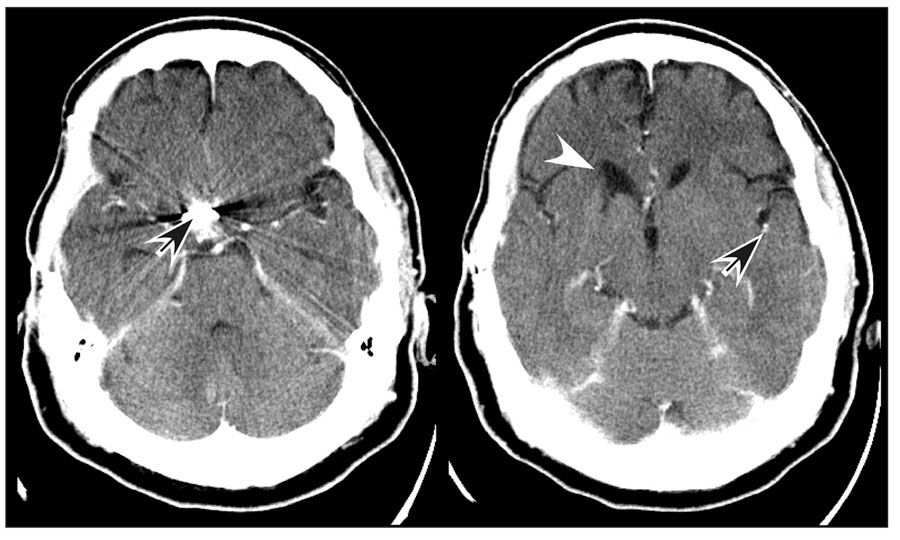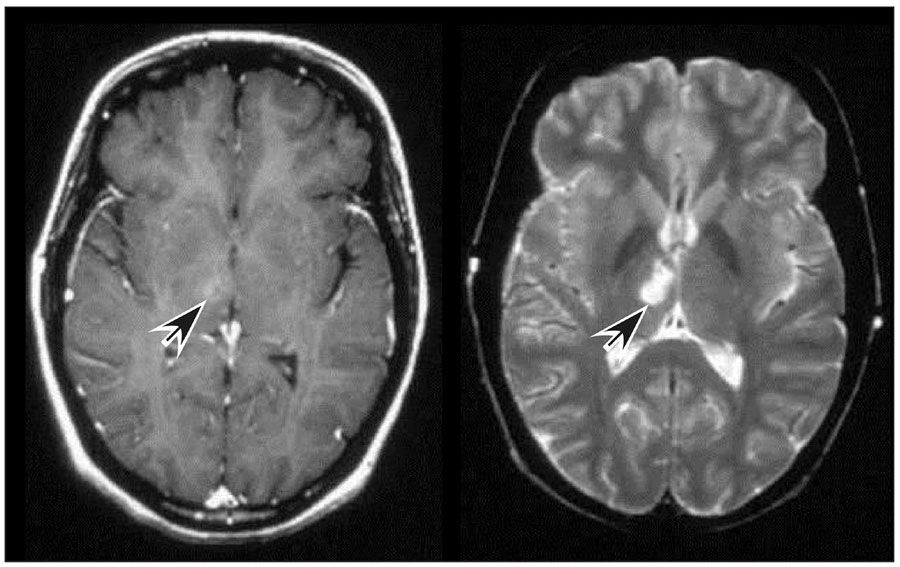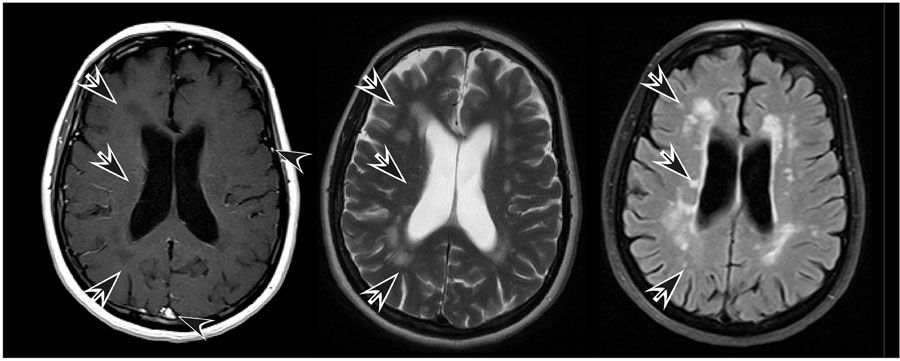Publication
Article
Psychiatric Times
A Practical Update on Neuroimaging for Psychiatric Disorders
Author(s):
Which neuroimaging test for which psychiatric patient-and when? What to ask the neuroradiologist?
Figure 1. Major cortical-subcortical circuit.

Figure 2. Imaging planes of section.

Figure 3. Clinical example 1.

Figure 4. Clinical example 2.

Figure 5. Clinical example 3.

Premiere Date: February 20, 2015
Expiration Date: EXPIRED
This activity offers CE credits for:
1. Physicians (CME)
2. Other
ACTIVITY GOAL
To understand when neuroimaging is needed for the diagnosis and management of a psychiatric disorder, and which neuroimaging technology is best suited.
LEARNING OBJECTIVES
At the end of this CE activity, participants should be able to:
1. Understand when neuroimaging may help with diagnosis and management of a psychiatric disorder.
2. Describe the differences between the available technologies
3. Decide which technique is best suited for the patient
TARGET AUDIENCE
This continuing medical education activity is intended for psychiatrists, psychologists, primary care physicians, physician assistants, nurse practitioners, and other health care professionals who seek to improve their care for patients with mental health disorders.
CREDIT INFORMATION
CME Credit (Physicians): This activity has been planned and implemented in accordance with the Essential Areas and policies of the Accreditation Council for Continuing Medical Education (ACCME) through the joint providership of CME Outfitters, LLC, and Psychiatric Times. CME Outfitters, LLC, is accredited by the ACCME to provide continuing medical education for physicians.
CME Outfitters designates this enduring material for a maximum of 1.5 AMA PRA Category 1 Credit™. Physicians should claim only the credit commensurate with the extent of their participation in the activity.
Note to Nurse Practitioners and Physician Assistants: AANPCP and AAPA accept certificates of participation for educational activities certified for 1.5 AMA PRA Category 1 Credit™.
DISCLOSURE DECLARATION
It is the policy of CME Outfitters, LLC, to ensure independence, balance, objectivity, and scientific rigor and integrity in all of their CME/CE activities. Faculty must disclose to the participants any relationships with commercial companies whose products or devices may be mentioned in faculty presentations, or with the commercial supporter of this CME/CE activity. CME Outfitters, LLC, has evaluated, identified, and attempted to resolve any potential conflicts of interest through a rigorous content validation procedure, use of evidence-based data/research, and a multidisciplinary peer-review process.
The following information is for participant information only. It is not assumed that these relationships will have a negative impact on the presentations.
Robin A. Hurley, MD, FANPA, has no disclosures to report.
Shiv Patel, MD, DABR, has no disclosures to report.
Katherine Taber, PhD, FANPA, has no disclosures to report.
Elizabeth Osuch, MD (peer/content reviewer), reports that she has received an independent investigator award from Pfizer.
Applicable Psychiatric Times staff and CME Outfitters staff have no disclosures to report.
UNLABELED USE DISCLOSURE
Faculty of this CME/CE activity may include discussion of products or devices that are not currently labeled for use by the FDA. The faculty have been informed of their responsibility to disclose to the audience if they will be discussing off-label or investigational uses (any uses not approved by the FDA) of products or devices. CME Outfitters, LLC, and the faculty do not endorse the use of any product outside of the FDA-labeled indications. Medical professionals should not utilize the procedures, products, or diagnosis techniques discussed during this activity without evaluation of their patient for contraindications or dangers of use.
Questions about this activity? Call us at 877.CME.PROS (877.263.7767).
Since the discovery of the x-ray in 1895, neuroimaging technology has advanced from primitive skull x-ray films to high-resolution visualization of brain structure and changes in brain activity induced by performing a task, solving a puzzle, or feeling an emotion. Neuroimaging is making increasing contributions to multiple aspects of clinical psychiatry, including differential diagnosis, prognosis, clinical management, and development of new interventions.1,2
There are 2 very different types of neuroimaging of value in clinical psychiatry.3,4 Structural neuroimaging techniques (eg, CT, MRI) provide static pictures of the scalp, skull, and brain. Functional neuroimaging techniques (eg, single photon emission CT [SPECT], positron emission tomography [PET], functional MRI [fMRI], electroencephalography [EEG], magnetoencephalography [MEG]) provide measures that are directly (MEG, EEG) or indirectly (SPECT, PET, fMRI) related to brain activity. The most commonly available functional imaging techniques use indirect measures (eg, cerebral blood flow, cerebral metabolic rate, blood oxygenation) of brain activation.
A study of nondemented psychiatric patients found that MRI examination had clinical impact in 15%.5 A study of psychiatric inpatients (general university hospital) with dementia reported that more than one-third of the structural imaging examinations (CT, MRI) and almost three-quarters of the functional imaging examinations (SPECT, PET) resulted in a change in diagnosis.6 The most common reasons for ordering neuroimaging were to rule out stroke or tumor and dementia differentiation.
Studies have documented the presence of psychiatric symptoms in patients with a wide range of conditions injurious to the brain, including cerebral vascular accidents, ruptured aneurysms, traumatic brain injury, and multiple sclerosis. The recognition that even subtle lesions can give rise to psychiatric symptoms grew out of the increasing understanding that emotion, memory, and thought processing happen by way of brain circuitry (Figure 1).7-9 A lesion anywhere within a circuit, including the tracts that connect nodes, has the potential to cause similar impairments.
The structural neuroimaging examination
Neuroimaging is recommended whenever there has been an injury to the brain. The information obtained can assist with the differential diagnosis, alter a treatment plan, and/or inform prognosis. Obvious examples include stroke and traumatic brain injury; less obvious are exposures (occupational, accidental, or intentional) to poisons or toxins (eg, cyanide, carbon monoxide, toluene, heavy alcohol intake). In addition, multiple clinical indications signal that a neuroimaging examination may be informative. The most important are the presence of clinical findings that are atypical, including unusual age of onset and/or evolution; movement disorders with psychiatric findings; abrupt personality changes with accompanying neurological signs or symptoms; sustained confusion or delirium; presence of subtle cognitive deficits (eg, multiple sclerosis).1,5,10-13
Types of structural neuroimaging
As noted above, CT and MRI both provide visualization of structures. They differ considerably in how the images are obtained, in the tissue origins (eg, gray matter, white matter, bone, cerebrospinal fluid), and in the appearance on the scans.
As with conventional radiography, CT uses an x-ray tube as a source of photons.14,15 To acquire each CT slice, a beam of photons rotates around the head. As the photons pass through the head, some are absorbed by the tissues. Detectors located opposite the beam source measure the remaining photons. Thus, CT images of the brain record tissue density. High-density tissues, such as bone, appear white. Air has the lowest density and appears black. Brain matter has an intermediate density and will appear gray.
Clinical MRI is based on manipulating the small magnetic fields around hydrogen atoms (protons), a major component of water in soft tissue.16,17 This manipulation and measurement involves the magnetic field generated by the MRI magnet, applying/stopping radio frequency pulses, and then measuring the energy signal given off during this process.
The creation of images also requires the application of small magnetic field gradients across the patient. These allow the computer to convert the signals into a spatial map-the MRI. The final output is a matrix consisting of a 3-dimensional image composed of many small blocks, or voxels. The voxel size for a common clinical scan is variable but approximately 1 mm on each side.
The strength of the magnet is measured in teslas (T). Most clinical imaging systems are 1.5 or 3.0 T, with a 1-m tube-shaped opening (bore).16,17 The narrow bore is one source of difficulty for patients, because it makes some feel uncomfortable or, frankly, claustrophobic. Open-design magnets that help the patient feel less confined are also available.18,19 Open systems are increasingly popular, although the image quality can be lower than in closed systems. The other source of difficulty is the loud noise associated with gradient switching and vibrating coils of wire in the magnet. These loud noises may occasionally distress the unprepared patient, although patients are given earplugs that greatly dampen the noise.
Acquisition methods have been developed that result in images sensitive to different aspects of the hydrogen atom’s behavior in a high magnetic field. As a result, each image type contains unique information about the tissues.16,17 Collection of the data at different points in the scanning procedure provides different clinical contributions. A T1-weighted (T1W) sequence is considered best for displaying anatomy because there are sharp margins between the gray matter of the brain (medium gray), the white matter of the brain (very light gray), and the cerebrospinal fluid (black).
The boundaries between the gray matter of the brain (medium gray), the white matter of the brain (dark gray), and the cerebrospinal fluid (white) are more blurred with T2-weighted (T2W) images compared with T1W images. This type of image is best for displaying pathology, which most commonly appears bright.
A useful variant on the T2W scan, called a fluid-attenuated inversion recovery (FLAIR) image, allows the intense signal from the cerebrospinal fluid to be nullified (appears dark). This makes pathology near these spaces much easier to see. FLAIR improves identification of subtle lesions, making it useful for neuropsychiatric imaging. Gradient echo sequences (sometimes called susceptibility weighted) are best for visualizing hemorrhage or calcium. Diffusion-weighted imaging is sensitive to the diffusional speed of free water in tissue.16 Visible changes occur within minutes of stroke onset, making diffusion-weighted imaging the method of choice for identifying ischemic stroke in the critical first few hours.20 Diffusion-weighted imaging is also informative in other conditions, including metabolic encephalopathies (eg, hypoglycemic, hyperammonemic, osmotic), infection, neurodegenerative conditions, and traumatic brain injury.21-23 Diffusion tensor imaging, a more complex version of diffusion-weighted imaging, is presently used primarily for clinical research.20
Contrast enhancement
Contrast agents are substances that change the signal on the image when administered intravenously before image acquisition.24 These agents are most commonly used for identifying areas in which the blood-brain barrier is broken. Normally, the blood-brain barrier keeps the contrast agent within the blood vessels. When a break in this barrier occurs, the contrast agent enters the injured area and collects in or around the lesion. CT contrast agents have higher density than tissue, so collections will appear as white on the scan. Unlike the contrast agents used in CT, the currently used clinical MRI contrast agents are not imaged directly. Rather, the presence of the contrast agent changes the T1 and T2 properties of hydrogen atoms (protons) in nearby tissue.
CT contrast agents
Currently, there are 2 types of iodinated CT contrast agents: ionic (high osmolality) and nonionic (low osmolality). Both are associated with allergic reactions, and there are contraindications for both; however, nonionic agents have a lesser rate of allergic reaction. It is the radiologist’s decision on choice of CT contrast agent. It is, however, prudent for the clinician to inform the radiologist if the patient has a history of previous allergic reactions to contrast dyes, diabetes, renal insufficiency, sickle cell disease, allergy to shellfish, or other debilitating or serious medical conditions before scanning. Metformin must be withheld following the use of an iodinated agent in patients with impaired renal function because it can cause (rarely) life-threatening lactic acidosis. It can be restarted after 48 hours with laboratory evidence of normal renal function.
MRI contrast agents
To make an MRI contrast agent, an ion of a highly paramagnetic metal is attached to a very strong ligand that prevents any interaction with surrounding tissue.25 This allows the metal complex to be excreted intact by the kidneys. The metal used in the 7 currently approved contrast agents for brain imaging is gadolinium. Tissue accumulation of an MRI contrast agent is most easily seen on a T1W scan because it increases signal (seen as a white or bright area). Adverse reactions/effects are generally low with MRI contrast agents, with the same caution for metformin as with CT contrast. It is again prudent to inform the radiology team of any debilitating medical conditions before sending the patient for scanning.26
fMRI takes advantage of a naturally occurring contrast agent. Deoxygenated hemoglobin (deoxyhemoglobin) is paramagnetic, whereas oxygenated hemoglobin is not. As a result, magnetic resonance image intensity is very slightly modulated by the local balance between oxygenated and deoxygenated hemoglobin in the blood (hence the acronym BOLD, for blood oxygen level–dependent). This balance changes when an area of the brain becomes more active. Thus, the areas of brain activated by a task can be identified by comparing images acquired during a baseline condition and while a task is being performed. The risks are the same as for clinical MRI.
Safety
Routine CT scans deliver a radiation dose of less than 5 rads. To avoid even this small dose of radiation to the lens of the eye, some institutions use a line drawn between the orbit and the external auditory meatus (referred to as the orbitomeatal line) as the inferior boundary of the brain CT scans, thereby avoiding most of the exposure to the lens.
To date, there appear to be no permanent hazardous effects from short-term exposure to magnetic fields and radiofrequency pulses generated in clinical MRI scanners.26,27 Volunteers scanned in systems with higher field strength have reported effects including vertigo and nausea.27 With very intense gradients, it is possible to stimulate peripheral nerves directly, but this is not a concern at clinical field strengths.26,27
There are, however, important contraindications to the use of MRI.26,27 The magnetic field can damage electrical, mechanical, or magnetic devices implanted in or attached to the patient. Pacemakers can be damaged by programming changes, possibly inducing arrhythmias. Currents can develop within the wires, leading to thermal burns, fibrillation, or movement of the wires or the pacemaker unit itself. Cochlear implants, cardiac defibrillators, dental implants, magnetic stoma plugs, bone growth stimulators, and implanted medication-infusion pumps can all be demagnetized or injure the patient by movement during exposure to the scanner’s magnetic field. In addition, metallic implants, shrapnel, bullets, or metal shavings within the eye (eg, from welding) can conduct a current and/or move, injuring the eye. Medication patches with metal foil backing are a risk for heating and for altered pharmacodynamics. All of these devices distort the magnetic resonance image locally and may decrease diagnostic accuracy. Metallic objects near the magnet can be drawn into the magnet at high speed, injuring the patient or staff.
Although there is no evidence of damage to the developing fetus, most authorities recommend caution. Judgment should be exercised when considering MRI for a pregnant woman.26,27 Difficulties also have been encountered when a patient requires physiological monitoring during the procedure. Several manufacturers have developed MRI-compatible respirators and monitors for blood pressure and heart rate.
Choice of imaging modality
The choice of imaging modality should be based primarily on the suspected condition (eg, brain injury, multiple sclerosis). If not contraindicated (eg, presence of metallic objects, severe claustrophobia), MRI is the preferred modality in most cases. Conditions best viewed with CT include bone pathology, acute blood, and calcification.14 MRI provides greater anatomical detail and higher sensitivity to most types of pathology, and it is not affected by bone artifacts. Thus, small lesions and all lesions near a bone (eg, brain stem, posterior fossa, pituitary, hypothalamus) are better visualized using MRI.
Clinical information needed for an imaging request
Provide clear and complete clinical information on the imaging request/computerized order (not just “rule out pathology” or “new-onset mental status changes”). Examples of the types of information that are of most value to the neuroradiologist include:
• A lesion is suspected in a particular location
• The patient has been exposed to a particular poison or toxin
• A specific disease process is suspected
Full clinical information is essential for guiding selection of the best imaging methods and parameters. The neuroradiologist and technical staff also need to be fully informed on any aspect of the patient’s current condition that might create difficulties during the scan. Examples of conditions that would require special management include delirium, psychosis, paranoia, agitation, significant tremor, high BMI.
Need for contrast enhancement
Within psychiatry, the clinician should consider requesting a contrast-enhanced imaging study if he or she suspects a condition that has a break in the blood-brain barrier (eg, abnormal non-contrast study with the recommendation of the neuroradiologist for further imaging, autoimmune disease, vascular pathology, malignancy).
Information for the patient
It is important to explain the procedure to the patient beforehand. Aspects of an MRI examination that are difficult for some patients are the loud noises of the scanner, the small bore, and the tightly enclosing imaging coil. In addition, all types of neuroimaging require absolute head immobility during the test. If you anticipate that the patient might become agitated or unable to remain still, light sedation may be necessary. As the ordering clinician, you are the one to prescribe any sedatives needed to complete the imaging examination.
The neuroimaging results
Neuroimaging examinations of the brain are recorded in 2-dimensional sections, and they are usually accompanied by a written report from the radiologist. CT scans are recorded in the axial (cross-section) plane most often. MRI scans are most often recorded in 3 planes-sagittal, axial, and coronal. Figure 2 provides examples of each of these planes. Most psychiatric clinicians visualize normal anatomical landmarks most easily on the axial plane. The coronal plane is good for visualizing small structures and for the radiologist to give a thorough examination of any pathology that is present.
When possible, if the patient’s written report indicates pathology, review the images with the radiologist before discussing the case with the patient and his family. If this is not possible, it is helpful to have some reference materials to consult on brain anatomy and circuit function before this discussion takes place. Remember, clinical images place the patient’s left on the viewer’s right. Also, if the images were brought on CD, verify that you are indeed reviewing the correct patient’s examinations and reports. Common questions from patients when discussing positive findings include the following: What does this mean in terms of my symptoms? Will this get worse? Will I get demented? How will this affect me in the future?
Conclusion
Neuroimaging can be of added value in the differential diagnosis, treatment planning, and/or prognosis for some psychiatric patients. Figures 3, 4, and 5 provide brief clinical examples of patient scans.
CME POST-TEST
Post-tests, credit request forms, and activity evaluations must be completed online at www.cmeoutfitters.com/PT (requires free account activation), and participants can print their certificate or statement of credit immediately (80% pass rate required). This Web site supports all browsers except Internet Explorer for Mac. For complete technical requirements and privacy policy, visit www.neurosciencecme.com/technical.asp.
PLEASE NOTE THAT THE POST-TEST IS AVAILABLE ONLINE ONLY ON THE 20TH OF THE MONTH OF ACTIVITY ISSUE AND FOR A YEAR AFTER.
Disclosures:
Dr Hurley is Associate Chief of Staff, Research and Education, W. G. (Bill) Hefner VA Medical Center, and Professor, Wake Forest School of Medicine, departments of psychiatry and radiology, VISN 6 Mental Illness Research, Education and Clinical Center (MIRECC) Associate Director, Education. Dr Patel is Staff Radiologist and Radiology Graduate Medical Education Site Director, W. G. (Bill) Hefner VA Medical Center, and Assistant Professor, Edward Via College of Osteopathic Medicine. Dr Taber is Research Health Scientist, Research and Education, W. G. (Bill) Hefner VA Medical Center and Research Professor, Edward Via College of Osteopathic Medicine, VISN 6 MIRECC Assistant Director, Education.
References:
1. Osuch E, Williamson P. Brain imaging in psychiatry: from a technique of exclusion to a technique for diagnosis. Acta Psychiatr Scand. 2006;114:73-74.
2. Filippi M, Agosta F, Barkhof F, et al; European Federation of the Neurologic Societies. EFNS task force: the use of neuroimaging in the diagnosis of dementia. Eur J Neurol. 2012;19:e131-e140, 1487-1501.
3. Malhi GS, Lagopoulos J. Making sense of neuroimaging in psychiatry. Acta Psychiatr Scand. 2008;117:100-117.
4. Carter E, Coles JP. Imaging in the diagnosis and prognosis of traumatic brain injury. Expert Opin Med Diagn. 2012;6:541-554.
5. Erhart SM, Young AS, Marder SR, Mintz J. Clinical utility of magnetic resonance imaging radiographs for suspected organic syndromes in adult psychiatry. J Clin Psychiatry. 2005;66:968-973.
6. Tanev K, Sablosky M, Vento J, O’Hanlon D. Structural and functional neuroimaging methods in the diagnosis of dementias: a retrospective chart and brain imaging review. Neurocase. 2012;18:224-234.
7. Bonelli RM, Cummings JL. Frontal-subcortical circuitry and behavior. Dialogues Clin Neurosci. 2007;9:141-151.
8. Haber SN, Rauch SL. Neurocircuitry: a window into the networks underlying neuropsychiatric disease. Neuropsychopharmacology. 2010;35:1-3.
9. Filley CM. White matter: beyond focal disconnection. Neurol Clin. 2011;29:81-97, viii.
10. Mueller C, Rufer M, Moergeli H, Bridler R. Brain imaging in psychiatry-a study of 435 psychiatric in-patients at a university clinic. Acta Psychiatr Scand. 2006;114:91-100.
11. Hurley RA, Fisher RE, Taber KH. Clinical and functional imaging in neuropsychiatry. In: Yudofsky SC, Hales RE, eds. The American Psychiatric Publishing Textbook of Neuropsychiatry and Behavioral Neuroscience. 5th ed. Washington, DC: American Psychiatric Press; 2008:245-300.
12. Sheehan W, Thurber S. Review of two years of experiences with SPECT among psychiatric patients in a rural hospital setting. J Psychiatr Pract. 2008;14:318-323.
13. Salinas C, Dávila G, Berthier ML, et al. Late-life reactivation of obsessive-compulsive disorder associated with lesions in prefrontal-subcortical circuits. J Neuropsychiatry Clin Neurosci. 2009;21:332-334.
14. Thomas RH, Burke CJ, Howlett D. Cranial computed tomography 1: technical aspects for clinicians. Br J Hosp Med (Lond). 2010;71:457-460.
15. Grignon B, Mainard L, Delion M, et al. Recent advances in medical imaging: anatomical and clinical applications. Surg Radiol Anat. 2012;34:675-686.
16. Moser E, Stadlbauer A, Windischberger C, et al. Magnetic resonance imaging methodology [published correction appears in Eur J Nucl Med Mol Imaging. 2009;36(suppl 1):S42-S43]. Eur J Nucl Med Mol Imaging. 2009;36(suppl 1):S30-S41.
17. Currie S, Hoggard N, Craven IJ, et al. Understanding MRI: basic MR physics for physicians. Postgrad Med J. 2013;89:209-223.
18. Bangard C, Paszek J, Berg F, et al. MR imaging of claustrophobic patients in an open 1.0T scanner: motion artifacts and patient acceptability compared with closed bore magnets. Eur J Radiol. 2007;64:152-157.
19. Enders J, Rief M, Zimmermann E, et al. High-field open versus short-bore magnetic resonance imaging of the spine: a randomized controlled comparison of image quality. PLoS One. 2013;8:e83427.
20. Lerner A, Mogensen MA, Kim PE, et al. Clinical applications of diffusion tensor imaging. World Neurosurg. August 5, 2013. http://www.worldneurosurgery.org/article/S1878-8750(13)00897-8/abstract. Accessed January 7, 2015.
21. Le TH, Gean AD. Neuroimaging of traumatic brain injury. Mt Sinai J Med. 2009;76:145-162.
22. Keogh BP, Henson JW. Clinical manifestations and diagnostic imaging of brain tumors. Hematol Oncol Clin North Am. 2012;26:733-755.
23. Bathla G, Hegde AN. MRI and CT appearances in metabolic encephalopathies due to systemic diseases in adults. Clin Radiol. 2013;68:545-554.
24. Weissleder R, Wittenberg J, Mukesh MGH, et al. Primer of Diagnostic Imaging. 5th ed. St Louis: Mosby Publishing; 2011:680-689.
25. Kanal E, Maravilla K, Rowley HA. Gadolinium contrast agents for CNS imaging: current concepts and clinical evidence. AJNR Am J Neuroradiol. 2014;35:2215-2226.
26. Kanal E, Barkovich AJ, Bell C, et al; Expert Panel on MR Safety. ACR guidance document on MR safe practices: 2013. J Magn Reson Imaging. 2013;37:501-530.
27. Coskun O. Magnetic resonance imaging and safety aspects. Toxicol Ind Health. 2011;27:307-313.






